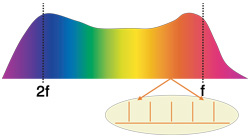Nobel Focus: Photons at the Forefront

The 2005 Nobel Prize in Physics celebrates the field of quantum optics, which concerns the quantum mechanical nature of light. Half of the prize goes to theorist Roy Glauber of Harvard University for his analysis of the behavior of light particles, or photons. The other half is shared by two experimentalists who used optics for extraordinarily precise measurements: Theodor W. Hänsch, of the Max Planck Institute for Quantum Optics in Garching, Germany, and the Ludwig-Maximilians University in Munich; and John L. Hall of JILA at the University of Colorado and the National Institute for Standards and Technology in Boulder, Colorado. The prize recognizes their techniques for measuring optical frequencies to an accuracy of 10-15. All three researchers published much of their seminal work in PRL and the Physical Review.
Theorists had completely described light’s quantum-mechanical nature by the late 1940s, but there was no fully quantum theory for the detection of light. In 1963 Glauber published a general theory in the Physical Review (following his short paper in Physical Review Letters [1]) that explained how the detection of one photon alters the remaining electromagnetic field, which in turn affects the probability of detecting the next photon. His work laid the foundation for areas such as the reduction of the fluctuations in a light signal to make it more predictable–so-called squeezing–and techniques for sending perfectly secret messages known as quantum cryptography. Daniel Kleppner of the Massachusetts Institute of Technology in Cambridge says that for several years Glauber was “a voice in the wilderness” but that other researchers eventually accepted his “highly original” analysis.
Hall and Hänsch devised a way to precisely measure the frequency of laser light. In the 1970s, physicists developed lasers whose spectrum contains not a single frequency–as you might expect for laser light–but a series of evenly-spaced frequencies called a “comb.” Neighboring light frequencies, or “teeth,” in the comb differ by less than a part in a million. Hänsch and two colleagues realized that they could use the comb as a ruler, measuring the frequency of a light source by finding its offset from the nearest tooth, and they published the idea in PRL in 1978. [Focus Supplement: Why the Comb Is So Uniform]
Although the spacing of the teeth was precisely known, the “absolute” frequencies of the comb depended on unknown details of the apparatus. Hall, Hänsch, and their colleagues cleared this last hurdle by sending the comb through a special optical fiber that generated new frequencies, extending the comb from near infrared to green. This frequency range was so wide that the team could compare the comb with an ordinary laser and a “frequency doubled” version of the same ordinary laser simultaneously. Knowing only that one beam was exactly double the frequency of the other–but not the precise frequencies–was enough for the researchers to determine the absolute frequency of every tooth in the comb, as they showed in 2000 in PRL. Soon after, Hall’s team achieved the same feat using one of the comb frequencies instead of the extra laser [2].
Previously, calibrating light to atomic frequency standards required a huge room full of lasers; it can now be done with a compact commercial instrument. The technique is likely to benefit fundamental experiments like satellite-based detection of gravitational waves, as well as technologies that need an optical frequency reference. It turns out that precise frequency control also allows researchers to adjust the timing of each cycle of the electric field in the laser’s brief pulses, allowing unprecedented control of chemical reactions triggered by laser light.
“It’s opened an area that people have only dreamt about,” says MIT’s Kleppner. “It’s such a powerful technology that you can’t help but feel confident that all sorts of things are going to be happening in the future.”
–Don Monroe
Don Monroe is a freelance science writer in Murray Hill, New Jersey.
References
- R. J. Glauber, “Photon Correlations,” Phys. Rev. Lett. 10, 84 (1963)
- D. J. Jones et al., “Carrier-Envelope Phase Control of Femtosecond Mode-Locked Lasers and Direct Optical Frequency Synthesis,” Science 288, 5466 (2000)


